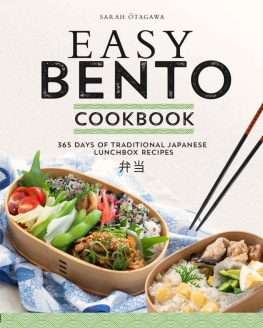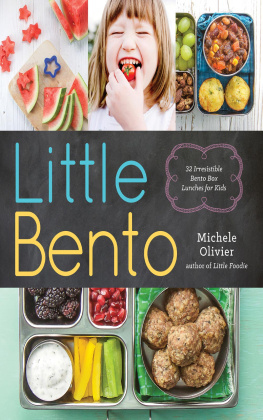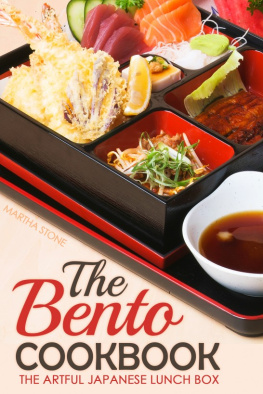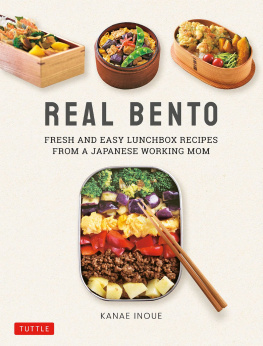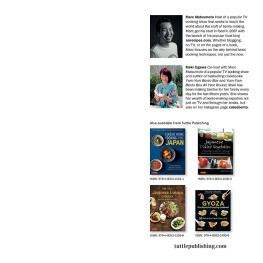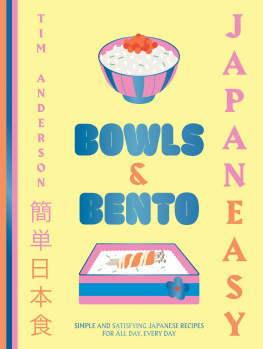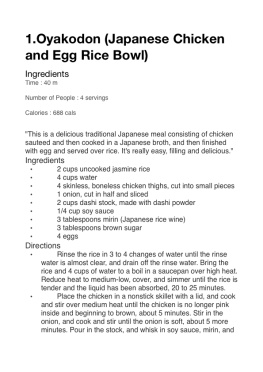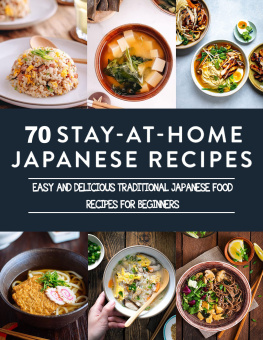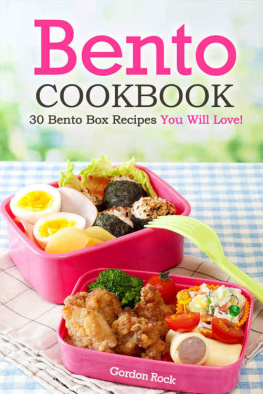Sarah Otagawa - Easy Bento Cookbook: 365 Days of Traditional Japanese Lunchbox Recipes
Here you can read online Sarah Otagawa - Easy Bento Cookbook: 365 Days of Traditional Japanese Lunchbox Recipes full text of the book (entire story) in english for free. Download pdf and epub, get meaning, cover and reviews about this ebook. year: 2022, publisher: Independently published, genre: Home and family. Description of the work, (preface) as well as reviews are available. Best literature library LitArk.com created for fans of good reading and offers a wide selection of genres:
Romance novel
Science fiction
Adventure
Detective
Science
History
Home and family
Prose
Art
Politics
Computer
Non-fiction
Religion
Business
Children
Humor
Choose a favorite category and find really read worthwhile books. Enjoy immersion in the world of imagination, feel the emotions of the characters or learn something new for yourself, make an fascinating discovery.
- Book:Easy Bento Cookbook: 365 Days of Traditional Japanese Lunchbox Recipes
- Author:
- Publisher:Independently published
- Genre:
- Year:2022
- Rating:4 / 5
- Favourites:Add to favourites
- Your mark:
Easy Bento Cookbook: 365 Days of Traditional Japanese Lunchbox Recipes: summary, description and annotation
We offer to read an annotation, description, summary or preface (depends on what the author of the book "Easy Bento Cookbook: 365 Days of Traditional Japanese Lunchbox Recipes" wrote himself). If you haven't found the necessary information about the book — write in the comments, we will try to find it.
Are you fascinated by antique Japanese traditions and its centuries-long cuisine secrets?
Would you like a multitude of recipes and ideas to always have balanced meals ready and planned for the whole week ahead?
If the answer is yes, you are ready to discover the beauty and simplicity of traditional Japanese recipes contained inside the Easy Bento Cookbook.
Modern life keeps blasting us with chaos and uncertainty. These times call for balance and harmony to be present in all aspects of our life, especially in our kitchens. My name is Sarah tagawa and Ive been running my own Japanese restaurant for 12 years. Cooking is for me a major source of joy, which is reflected in the faces of hundreds of satisfied as they fall in love with Japanese cuisine.
Bentos lunch boxes are a way to take a break from our work, study, or activity and take a little time to really enjoy food, appreciate its flavor and savor the moment.
The Easy Bento Cookbook is the perfect introduction to Bento box lunches for beginners who want to dive into Japanese cooking, with both traditional and creative recipes, plus many helpful tips for getting started.
Bento books have been some of the most demanded and successful cookbooks in Japan over the last few years. The Bento fever has recently swept across the West too, fuelled by the desire for a convenient and healthy approach to eating, even in times of hardship.
With the Easy Bento Cookbook, I want to give you extremely clear and easy-to-follow recipes you can use right away to fill your boxes with.
From Japanese classics to simple fusion and Western-inspired bento boxes, youll be eating variety-filled, home-cooked lunches in no time, with:
- More than 100 recipes to create the perfect balance of protein, carbs, and sides in the box
- Step-by-step instructions for each recipe, with nutrients and timing to help you plan ahead and always be in control of your family diet
- Many vegetarian and vegan options included to satisfy all tastes and preferences
- Tips, tools, shortcuts, and ingredients to seamlessly implement the convenience of bento boxes into your daily routine.
- All the information you need on the Bento Box itself: sizes, different variations, and the right colors to make your bento look amazingly good!
- Delicious recipes and bento menu suggestions, including Japanese Bunny Apple Snacks, Teriyaki Salmon, Juicy Nikujaga, Lotus Root Stir-fry, Spicy Tuna Donburi Bowl, and many many more!
The Easy Bento Cookbook is an accessible, authentic bento cookbook for everyone to enjoy. You will be able to prepare mouthwatering lunch boxes for your family in very little time.
This is my Bento encyclopedia for you. Traditional Japanese cuisine is one of the most beneficial ways I know to part from modern chaos and cultivate a passion for the beautiful things in life. I enclosed all my experience in these pages, and I hope you will be able to find inspiration and great taste within its pages.
Scroll back up and hit the Add to Cart button to make your family enjoy Japanese food every day and discover the health and convince of Bento boxes!Sarah Otagawa: author's other books
Who wrote Easy Bento Cookbook: 365 Days of Traditional Japanese Lunchbox Recipes? Find out the surname, the name of the author of the book and a list of all author's works by series.

